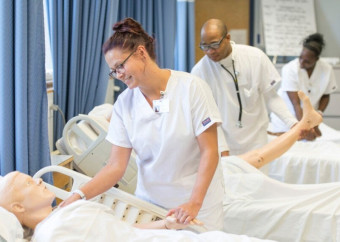Design Thinking For Beginners
Tags: Design Thinking
Apply the five-step design thinking process to identify and creatively solve problems using a human-centered approach.
Last updated 2022-01-10 | 4.3
- Apply the 5-step design thinking process to a design challenge in your organization.- Empathize with your user through interviews and observations
- in order to take a human-centered approach to a problem.
- Define your core problem by synthesizing and analyzing information gathered during your empathy work.
What you'll learn
* Requirements
* You should be comfortable in the skills of your own profession in order to effectively apply design thinking principles to a challenge relevant to your field.Description
National Association of State Boards of Accountancy (NASBA)
NASBA CPE credits: 1.8
Recommended NASBA field of study: Personal Development
Program level: Beginner
To earn NASBA CPE credits:
- Complete all videos
- Score 70% or higher on final exam
Glossary: Find PDF attached to the first lecture of this course.
Completion to obtain CPE should be accomplished a year after purchase date.
If you undertake this course for NASBA CPE credits, please complete the Self Study Course Evaluation.
Udemy is registered with the National Association of State Boards of Accountancy (NASBA) as a sponsor of continuing professional education on the National Registry of CPE Sponsors. State boards of accountancy have the final authority on the acceptance of individual courses for CPE credit. Complaints regarding registered sponsors may be submitted to the National Registry of CPE Sponsors through its website: www.nasbaregistry.org. For additional information including refunds and complaints, please see Udemy Terms of Use. For more information regarding administrative policies, please contact our support.
Course content
8 sections • 38 lectures
Introduction & Hello! Preview 01:04
Welcome to "Design Thinking for Beginners"! In this video, you will meet your instructor and get a basic overview of what to expect for the rest of the course. Let's dive in!
Your Design Project Preview 01:31
Throughout this course, you'll work on a design challenge that is relevant to your organizational context. While you can choose any design challenge you would like, we would encourage you to choose from the following list of suggested challenges:
- How Might We… better evaluate and measure the output of employees, moving away from simply “hours spent sitting at the office?
- How Might We… help employees feel more connected to the mission of the organization, at all levels?
- How Might We… increase collaboration across teams, in order to break down organizational silos?
- How Might We…redesign our space to best support the type of work employees are doing and the environment they need to thrive in that work?
- How Might We… redesign the meeting experience, to make meetings feel like the most productive time of the workday?
[Download] Course Workbook Preview 00:17
Go Try It! Assumption Storm Preview 00:50
At the beginning of any design project. It's important to uncover your own assumptions about the problem space you will be exploring. In this activity, you will start with the design challenge you chose in the previous video, and uncover all of your assumptions about the existing needs and possible solutions.
What is Design Thinking? Preview 02:14
The design thinking process as developed and popularized by the Stanford d.school is a 5-step process - empathize, define, ideate, prototype and test. There are two phases of this process: problem finding (empathize and define) and solution finding (ideate, prototype, test).
Who Uses Design Thinking? Preview 02:03
More and more companies are using the design thinking process to uncover user needs and design solutions that will delight their customers. In this video, learn about how three companies have adapted the Stanford d.school process, to help it fit into their unique cultures.
The Value of Design Thinking Preview 01:24
Companies want to know that their investments of time and resources will be good for their bottom line. To have the greatest impact with design thinking in your organization, throughout this course consider how the process fits into your organizational culture and how it will lead to a high return on investment.
CPE Review Quiz: Section 2
Let's review what you've learned in Section 2.
Challenge Your Assumptions Preview 01:22
Remember in the intro material, we had you assumption storm? This is because in order to see other perspectives, you need to understand your own first. The earlier we acknowledge we have our own views and perspectives, the easier it is to move past them, and actively seek out other perspectives, a goal of the empathy stage.
Methods of Empathy Preview 01:48
There are 3 main methods of empathy work - immerse, observe, engage. Engage, or interviewing, is the most common form of empathy work, and the technique we will spend the most time introducing.
Each of these methods gives you a different perspective on the challenge:
- Engage: allows you to get unique perspectives from your various stakeholders on the problem space.
- Observe: allows you to use your 5 senses to understand your users and your problem space.
- Immerse: allows you to experience your user’s needs from the first person perspective.
Interviewing Techniques Preview 02:29
In advance of going into an interview, it’s helpful to prepare an interview guide. Having an interview guide allows you to actively listen, instead of always worrying about what your next question will be.
The flow of questions in the suggested interview guide are:
- Ice Breaker
- Grand Tour
- Dig Deeper
- Magic Wand
To learn more about each of these question types, watch the video, and review the workbook.
Empathy in Action Preview 03:29
In this video, I’m going to demonstrate how to conduct an interview. If you watched the last video, you’ve seen that I’ve prepared an interview guide to interview Stephanie, a mother of a teenager, in advance.
Go Try It! Interview and Observe Preview 00:40
It’s your chance to go practice empathy work! Your task:
- Observe people engaging in the task or environment you’re hoping to redesign.
- Immerse in that task or environment (if you can - this is the hardest).
- Develop an interview guide.
- Engage at least 5 people by interviewing them about their experience in the task or environment.
CPE Review Quiz: Section 3
Let's review what you've learned in Section 3.
Synthesis Frameworks Preview 02:15
After talking to a user, it’s important to take time to synthesize what you heard and try to make sense of it. Many designers think this is the part of the process that takes the most work. There are many frameworks for this. We’ll use the most common one here - say, do, think, feel.
Personas Preview 02:05
Hopefully at this point in your design project, you’ve talked to a lot of people with a lot of perspectives! A persona helps you to flesh out the needs of each of the stakeholder groups you have interviewed.
There are a lot of frameworks for personas. For the purposes of this assignment, we’ll use the following categories:
- Characteristics
- Social Environment
- Tools & Environment
- Convictions & Beliefs
- Fears & Doubts
Point of View (POV) Statements Preview 01:31
Depending on which stakeholder you design for, your solutions will be different. Writing a point of view statement will help you narrow in on the needs of the specific stakeholder group you will design for. We use a madlib-like sentence starter for our point of view statements:
I met ______. I was surprised to realize ______. I wonder if this means ______. It seems like he/she needs a way to_____.
Go Try It! Synthesis and POVs Preview 00:45
It’s your chance to go practice define work! Your task:
- Create say-do-think-feel maps for each of the interviews you conducted.
- Create personas for each of the stakeholder groups you encountered in your empathy research.
- Write a point of view statement for the persona you have chosen to design for.
CPE Review Quiz: Section 4
Let's review what you've learned in Section 4.
"How Might We..." Statements Preview 02:12
How might we statements are the bridge between problem-finding and solution finding. You might remember these words - it’s how we framed each of the initial challenges we offered you! At this point in the process, it’s about making the challenge feel smaller and more actionable.
HMW Statements: Find and Fix the Mistake
Based on the best practices I described in the last lecture for generating "How might we..." statements, find and fix the issues you see in the following statements.
Ideation Tips and Tricks Preview 01:54
Time to brainstorm! Before you try your own, here are some tips for making a brainstorm feel successful:
- One conversation at a time: helps us to build on each others’ ideas
- Stay focused on the need you’re trying to solve for: there are lots of good solutions in the world that haven’t been built yet, but let’s try to focus on the ones that address your POV.
- Headline your idea: helps the brainstorm to go quickly!
- Be visual: it’s ok if you can’t draw - thinking visually triggers a different part of your brain than thinking in words.
- No idea is a bad idea: judgement of the ideas can come later.
- Go for quantity: If you have 100 ideas, the likelihood that one of them is good is a lot better than if you only come up with 10.
- You might need to throw in some crazy ideas: sure they might not be feasible, but it might spark an idea for someone else, or maybe there’s an element of it that could be worth exploring.
Ideation in Action Preview 03:08
In this video, I’m going to demonstrate how to run a brainstorm. If you watched the last video, you know that I will be encouraging my team of collaborators to follow some rules of brainstorming, while trying to generate potential solutions for our user.
Go Try It! Ideation Session Preview 00:34
It’s your chance to go practice ideation work! Your task:
- Write 5-10 different how might we statements to direct your brainstorm.
- Recruit 2-4 of your friends/colleagues.
- Run at least one brainstorming session, using your How Might We statements as a guide and following the “rules of brainstorming.”
CPE Review Quiz: Section 5
Let's review what you've learned in Section 5.
What is a Prototype? Preview 02:12
At a lot of companies, a prototype is an expensive endeavor. That’s NOT what we’re talking about here. It’s important that your prototype is low fidelity and quick to make.
When we make something that we spend a lot of time on, our feedbackers are often more hesitant to give us feedback. We also feel more attached to it. It’s really easy to throw out an idea you’ve spent 5-10 minutes fleshing out. Much harder for something you devoted months (and likely a lot of money doing!)
Testing a Hypothesis Preview 01:30
Usually our prototypes are trying to answer a question. Think about it as a hypothesis. At this point in the design process, you likely have lots of hypotheses! That’s great. Prototypes are meant to help you test them out, one at a time.
Testing as Empathy Preview 00:53
When we test our prototypes with our users, it’s a way to check back in with them and make sure that we haven’t baked our own assumptions into the design.
It’s something that happens a lot in design. Even though we started with the user’s perspective, over time, we’ve started to hone in on the solutions we, as designers, are most drawn to. So, when we test our prototypes, we have the chance to again connect with our users, and see if we’re headed in the right direction.
Testing in Action Preview 02:44
In this video, I’m going to demonstrate how to conduct a prototype test. I have considered my scene, props, and roles and will be bringing my prototype to the library to test with my target stakeholder group - teenagers.
Go Try It! Build & Test Preview 00:27
It’s your chance to go practice prototyping and testing work! Your task:
- Build at least one low-resolution prototype.
- Test each prototype with 3-5 users (and remember, think of this as a second round of empathy!)
CPE Review Quiz: Section 6
Let's review what you've learned in Section 6.
The Power of Storytelling Preview 01:22
Humans LOVE stories. We remember events and experiences better when we can tell the narrative of them. In design, we use stories in many ways - to better share our users lives and journeys with our colleagues, to fit our prototype into the larger narrative of our users lives and, to make the pitch for why design thinking is an important method.
The 3 principles of storytelling you will use are:
- Know your audience - why do they and should they care?
- Keep it concise - especially if you’re going to send it in email form.
- Draw on emotions - what emotion do you want your audience to feel after hearing your story?
Developing Your Pitch Preview 00:54
Many organizations are intrigued by the idea of design thinking. It promises a lot of potential for growth and innovation. However, it can be hard for companies to agree to bring this new process in because they can’t see how it fits within their context.
So, one added principle of storytelling that we’ll add for this particular challenge of thinking about and promoting change is:
- Make the change feel incremental, while also inspiring - if it feels like you're building on existing momentum, sometimes change feels a little less scary.
Pitching in Action Preview 02:12
In this video, you will hear two pitches. One that follows our principles of storytelling and one that doesn't. Which one is more compelling? Why?
Go Try It! Write Your Pitch
In this assignment, you will use storytelling to write a pitch for design thinking to use at your organization.
CPE Review Quiz: Section 7
Let's review what you've learned in Section 7.
Thank you! Preview 01:19
Thanks for joining me in this introduction to design thinking. A few things to remember as you continue on your design thinking journey:
- Design thinking is all about focusing on your user’s needs and building and testing to solve for that need.
- You’re not an expert yet! But, you have the skills you’ll need to get there.
- Design thinking is best done in collaborative groups. Once you feel comfortable, bring others into it with you!
- Designing for your user’s need is necessarily an iterative process. As you test, you’ll uncover new needs. While you learned this in a very linear way, it doesn’t usually feel like that “in the wild.”
And please, don't forget to rate and review the course!
CPE Qualified Assessment
In order to receive CPE credit for this course, you must a) complete all course content, and b) pass this qualified assessment with 70% or greater.








 This course includes:
This course includes:













